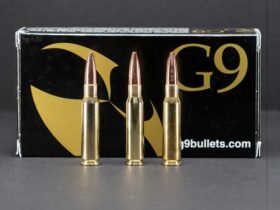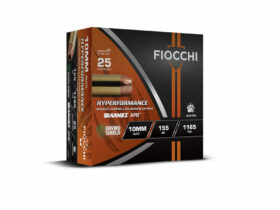In my prior articles on the .450 Bushmaster, I built a hunting rifle with the help of Brownell’s and subsequently experienced significant feeding issues with it. I solved these problems with the help of Tromix and got the gun running smoothly. In this article, we will look at .450 Bushmaster ammunition and how to get the best accuracy out of your .450 rifle.
To start, we need to lay down some ground rules about the performance of the .450 in general. The round isn’t an exceptionally accurate one by most standards, but it is very far from being a rock in a sock. The .450 is not a long-range cartridge, but it is plenty good for hunting in virtually all places in the country except, perhaps, the wide-open plains. Most, including myself, believe it to have an effective range of about 250 yards. It generates a tremendous amount of power at close ranges and is, essentially, a very large pistol cartridge. You could think of the .450 as a large .45 ACP in almost every respect.
For this ammo accuracy and velocity test, I used a very nice SWFA SS 3-15x42mm scope. This is an almost recoil-proof tank of a scope that I’ve used for years. To mount it to the rifle, I selected the rock-solid Midwest Industries MI-QD30-SM quick-detach scope mount. This mount is able to stand up the recoil of the .450 with ease and returns to zero. This combination of scope and mount is what the .450 needs. You can’t have anything moving, especially what you aim with.
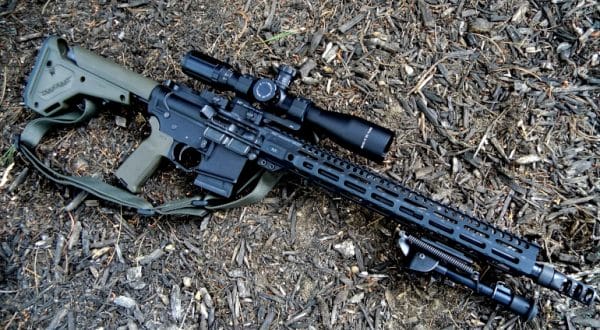
The ammunition that I’ll be looking at in this article comes from two companies: Hornady and Buffalo Bore. The ammo from Hornady comes in the form of two basically identical loads, one being the 250gr FTX Custom and the 250gr FTX BLACK. These loads are identical as far as specs on the Hornady site and have an advertised muzzle velocity of 2200fps. The bullets used for this load have Hornady Flex Tip technology and are widely known to be very effective.
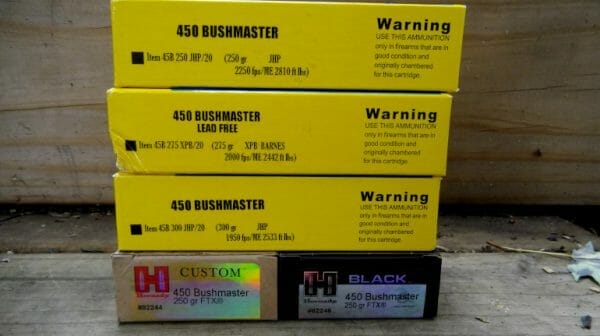
The Hornady loads are some of the first to come out on the market for the .450, and they have always been solid performers. I have taken this load hunting in the past in a bolt action I built several years ago when the Michigan hunting laws changed to allow straight-walled cases.
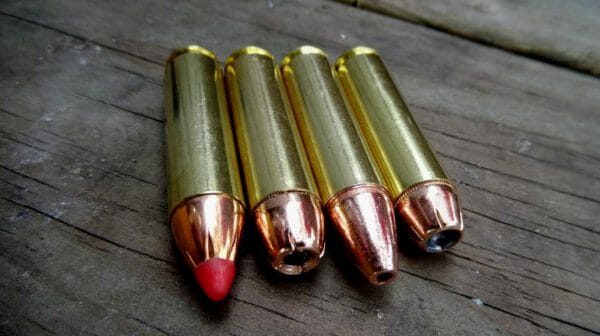
I tested these loads for velocity over my Oehler 35P chronograph, and they came in exactly the same at an average of 2165fps, which is very close to the stated velocity from the manufacturer (Hornady lists the 2200fps from a 20” barrel, mine is 16”) and was very consistent. The accuracy (after I figured out some issues) came in at 1.5” for five shots at 100 yards.
The Buffalo Bore loads are very new on the scene. As of this year, I received three different loads to test: the 300gr JHP, 250gr JHP, and 275gr XPB Barnes Lead-Free. These loads are all a far cry from the original .450 offerings, and two of them have conventional rounded pistol bullets in them as opposed to a pointy rifle bullet.
The claimed velocity for the 300gr JHP load is 1950fps. My rifle fired this load at a five-shot average of 1920fps. This load generated the most recoil out of any .450 load I fired, and it also showed the most drop of any load, falling about 14” at 200 yards from a 100-yard zero. It was quite accurate considering the bullets used and generated 5-shot groups of 2.9” at 100 yards.
The next load, the 275gr XBP, has a stated velocity of 2000fps. My rifle fired it at 1922fps and averaged 2” for five shots at 100 yards. This was a very low-recoil load, and it was very comfortable to shoot. I noticed that it appeared to also be slightly lower pressure judging by a rounded primer flatness and smooth, easy ejection of cases.

The final Buffalo Bore load is the 250gr JHP. The manufacturer says this is a load designed for deer hunting and has a bullet designed to expand at pistol velocities. At a claimed velocity of 2250fps and matching speed of 2249fps from my rifle, this load certainly was faster than pistol velocities and produced the fastest speeds of any round I tested among this group. It was acceptably accurate at 2.5” for five shots at 100 yards.
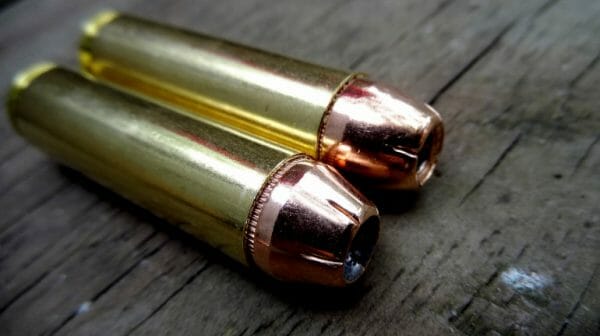
So this brings us to accuracy and the mechanical accuracy of the rifle itself. My gun performed very differently with each of these loads, and I had accuracy issues with the gun itself, not the ammo. I discovered another problem that resulted from the magazines and the restriction of the action. I am not an expert on this by any means, but I noticed that the magazines had a real effect on how the gun shot.
When I loaded the gun with a single round and fired for a group, it produced excellent accuracy. When I put a loaded mag in, I had groups open up and sprayed all over, often raising group size to double what the single rounds were. I discovered that when I used the Lancer magazines with the Tromix followers, the accuracy tightened. My thought on this is that the upward pressure being placed on the bolt carrier caused minute flex and put pressure on the upper receiver, pushing it away from the lower. This stress then caused the bolt carrier to operate sluggishly or move irregularly.
Does this mean that you have to be careful of what mags you use in your .450 rifle? At least in an AR, you might have to. The AR design wasn’t made to handle these big-bore rounds and is somewhat fragile, thus making a complex situation of trying to maintain accuracy. At the same time, various pressures are exerted on your moving parts. The best thing that can be done for accuracy in a .450 is to not try to stuff so many rounds into a mag that the bolt can’t travel.

A topic that I brought up in my last article was case taper. The .450 is a straight-walled case in that it has no bottleneck. It does have a minute taper from base to mouth, and as a result, the rounds can lift in the magazine. I noticed some small differences in the shape of the Buffalo Bore loads as opposed to the Hornady offerings. The Buffalo Bore cases, most notably that of the 300gr JHP, have what could only be described as an undetectable difference in case taper that made it easier for them to lift up in the magazine with a standard follower installed. This problem vanished with the Tromix followers.
As far as the general accuracy of the cartridge is concerned, groups in the 1-3” range aren’t bad. I know some people claim that this is terrible, but in real life, it is fine. I shoot from field positions with the bipod, which is perfectly acceptable for hunting use.
There are many people out there that would have you believe that this is a one-hole cartridge at 300 yards, and I’m certain that there are many very accurate guns out there that can do it (the Ruger No.1 I will be reviewing in my next article is certainly one of them), but not every .450 is going to do that. The AR rifle has many complicated intricacies, and making it accurate with a giant pistol cartridge is no easy feat. The bullets are not very aerodynamic, are very heavy, and are relatively slow.
I think that each of these .450 cartridges has a place. Buffalo Bore, in addition to the three loads I tested, makes a 360gr hard-cast lead load that was designed for bear hunting. I didn’t test it here, but the fact it exists shows the range of use the .450 has.
In the future, there will likely be more good .450 loads available. In another article I will test handloads, and what you can expect to see when rolling your own, using some very fascinating bullets. The fact that the .450 is rapidly gaining popularity only serves to make me believe that I’ll see some fantastic bullets and amazing ammo types in the future. There isn’t much you can’t do with the loads I tested here, but it will certainly be nice to see the future of this cartridge.
Ammo for this article can be seen at www.buffalobore.com and www.hornady.com.
The parts for the rifle can be found at www.brownells.com, www.tromix.com, and www.midwestindustriesinc.com.
About Josh Wayner
Josh Wayner has been writing in the gun industry for five years. He is an active competition shooter with 14 medals from Camp Perry. In addition to firearms-related work, Josh enjoys working with animals and researching conservation projects in his home state of Michigan.
Source link: https://www.ammoland.com/2023/07/450-bushmaster-ammunition-and-accuracy-testing/ by Josh Wayner at www.ammoland.com



